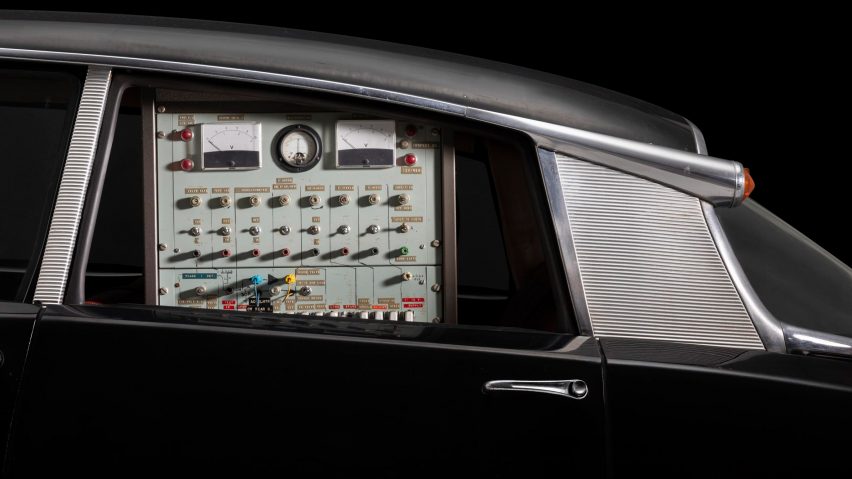An exhibition at London's Science Museum explores the future of autonomous mobility, and the designs that are paving the way. Curator Margaret Campbell selects five pieces from the show and reveals the stories behind them.
Driverless: Who is in Control? opened at the Science Museum earlier this month and will remain on view until October 2020.
While autonomous cars may seem an abstract concept to many drivers, the exhibition aims to show visitors just how much of this "seemingly futuristic" technology already exists.
The exhibition is made up of three zones: Land, Air and Water and looks at developments in all these areas.
Objects on display include the self-driving electric racing car, Robocar, and artist Dominic Wilcox's stained-glass Sleeper Car design for a future where driverless technologies make roads safe enough to drive vehicles made of glass.
According to Campbell, nearly 60 years ago researchers predicted that most cars in Britain would be autonomous by 2010, but this is yet to be fully realised.
"The exhibition explores not just the technological challenges that must be overcome before this becomes reality, but the social, political, and ethical ones as well," said the curator.
"It asks timely questions about how much control we're willing to cede to AI machines and how driverless technology could transform our world."
Here, Campbell explains five designs from the show that best illustrate the thinking behind autonomy:
Citroen DS19
"The idea behind self-driving cars is older than you might expect. This beautiful Citroen DS19, from the Science Museum collection, is the oldest object in the exhibition, having been modified by the Road Research Laboratory (RRL) in 1960 to guide itself along an electric cable.
"Early experiments on a test track in Berkshire, England, were such a success that the engineers behind the project were allowed to install nine miles of cable under a stretch of the M4, near Reading. At the time, the RRL predicted that most cars in Britain would be self-driving by 2010.
"Nearly 60 years later, this idea remains in the distant future. Driverless explores not just the technological challenges that must be overcome before this becomes reality, but the social, political, and ethical ones as well."
Defibrillator delivery drone by Karolinksa Institute
"When seconds count, self-flying drones could soon mean the difference between life and death for victims in cardiac arrest.
"The Karolinska Institute in Sweden developed a drone capable of delivering a defibrillator to someone in need 16 minutes before emergency medical services could arrive by road. But, like many other jurisdictions, Sweden does not currently allow anyone to fly a drone out of their sight.
"For many autonomous technologies currently in development, their slow introduction to the market is the result of regulatory challenges, not technological ones. In remote areas, drones like this one, and the many others like it currently in development, could save lives.
"But some researchers predict that by 2035, 175,000 drones could fly over cities like Paris every hour, raising questions about how we want this technology to be used and how prevalent it could become."
Hacked stop sign
"The graffiti on this stop sign was added by a group of researchers who set out to 'hack' the technology used in self-driving cars. While vandalism on a stop sign doesn't change its meaning to a human driver, it makes it unrecognisable to a driverless car relying on cameras and artificial intelligence (AI) to understand the world around it.
"This experiment exposes some of the weaknesses of this technology and raises questions about how a greater reliance on AI could leave us vulnerable to other forms of hacking.
"Many organisations have serious concerns about what decisions AI could be allowed to make in the future, especially moral or ethical ones. If we struggle to agree on what is moral or ethical, how can we decide what AI will be programmed to value?"
Roboat
"Roboat is a floating platform that uses lidar (laser imaging, detection and ranging systems) to find its way around, transporting people and goods, or collecting waste. Roboats can also coordinate with one another to form bridges or event spaces.
"The developers behind Roboat want to reduce traffic on city streets by shifting some of it onto water. They are currently testing this prototype in Amsterdam, but it could someday be used in cities like Venice or Bangkok.
"Communication between autonomous vehicles is one of the most exciting parts of this technology. It could change how urban spaces are designed, making cities less congested and allowing us to move around more efficiently."
The Autosub Long Range, known as Boaty McBoatface
"The Autosub Long Range was affectionately nicknamed Boaty McBoatface, following a public vote that has made it the most well-known autonomous submarine in the world.
"The model we have in the exhibition is to two-thirds scale – the real one is currently collecting crucial data in the Antarctic that will help scientists better understand how quickly our climate is changing and how much glaciers on the continent could contribute to sea-level rise.
"The National Oceanography Centre hopes that the Autosub could one day make the world's first under-ice crossing of the Arctic, demonstrating how self-driving vehicles are allowing us to explore new places and do vital research."

